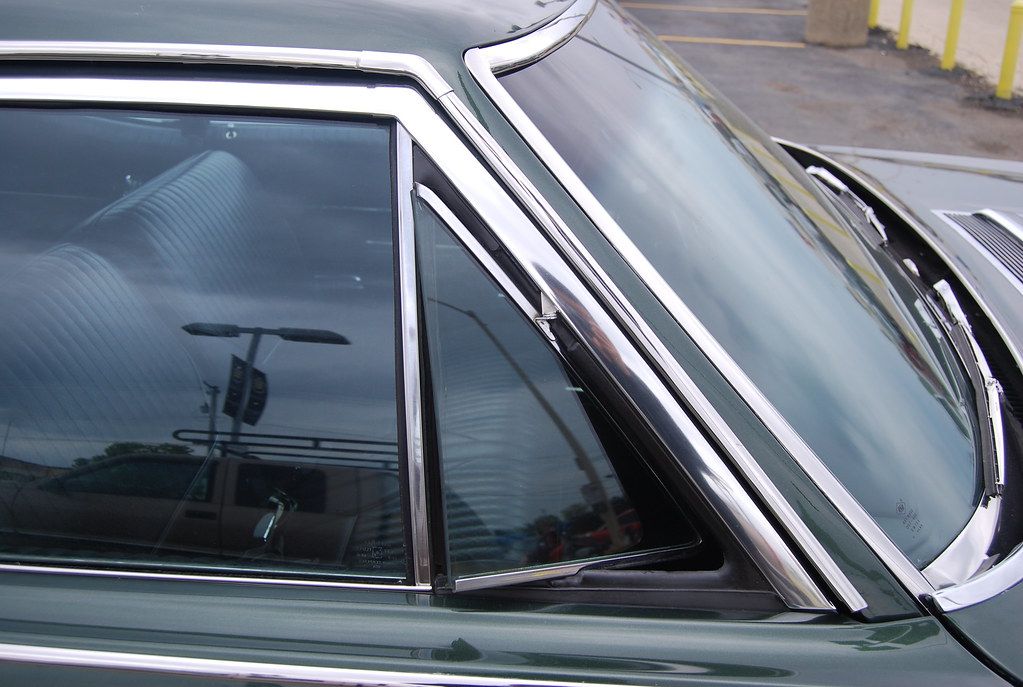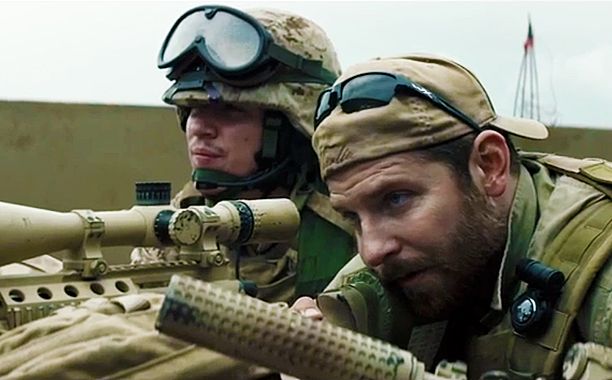
From the earliest days of warfare, the ability to strike a target with unmatched precision from a hidden vantage point has been a game-changer. The concept of the sniper—a military or paramilitary marksman who engages targets from positions of concealment or at distances exceeding the target’s detection capabilities—has evolved dramatically, driven by incredible engineering and the relentless pursuit of accuracy. These skilled individuals, equipped with specialized training and cutting-edge rifles, have profoundly influenced conflicts across centuries, demonstrating the sheer power of a single, well-placed shot.
Modern snipers are far more than just marksmen; they are vital components of tactical intelligence. Often serving as scouts and observers, they feed crucial information back to their units, playing roles in target acquisition, impact feedback for air strikes, and even counter-sniper tactics. The demand for their weapon systems is immense: these rifles must perform under extreme pressure, maintain their accuracy across vast distances, and remain utterly reliable through rugged field transport and unforgiving combat environments. It’s a testament to human ingenuity and mechanical precision.
Today, we embark on a fascinating journey through history, examining some of the most influential sniper systems that have graced battlefields and defined the art of long-range engagement. These aren’t just firearms; they are masterpieces of engineering, each with a story of innovation, impact, and an enduring legacy. We’ll explore how these legendary rifles, from the pioneering designs of centuries past to the sophisticated instruments of modern warfare, have consistently met the formidable challenge of delivering precision when it matters most.

1. **The Baker Rifle: A British Breakthrough in Precision**
The early 19th century marked a significant turning point in military marksmanship, largely due to the introduction of the Baker rifle. Before its advent, most troops were armed with notoriously inaccurate smoothbore muskets, making long-range precision a mere dream. However, the British Army’s “Experimental Corps of Riflemen” spearheaded a change, adopting this formidable weapon which promised a new era of engagement.
What made the Baker rifle so revolutionary was its rifled barrel. Unlike smoothbores, its internal grooves, combined with a leather wad to ensure a tight seal, imparted a spin to the projectile, vastly increasing stability and accuracy over distance. This design breakthrough meant that while it was “slower to load” compared to its smoothbore counterparts, the gains in precision were absolutely game-changing on the battlefield.
The adoption of the Baker rifle by specialized units, later known as the 95th Rifles, allowed for unprecedented tactical flexibility. It empowered marksmen to target specific high-value enemy personnel with a reliability that had been previously unimaginable. This rifle wasn’t just an incremental improvement; it was a foundational step in the development of the dedicated sniper rifle, demonstrating that superior weapon design could directly translate into a decisive combat advantage, even with early 1800s technology.
Military equipment: Timeline of the Russo-Ukrainian war (12 November 2022 – 7 June 2023)
Categories: 2022 in Russia, 2022 in Ukraine, 2022 timelines, 2023 in Russia, 2023 in Ukraine
Summary: This timeline of the Russo-Ukrainian war covers the period from 12 November 2022, following the conclusion of Ukraine’s Kherson and Kharkiv counteroffensives, to 7 June 2023, the day before the 2023 Ukrainian counteroffensive began. Russia continued its strikes against Ukrainian infrastructure while the battle of Bakhmut escalated.
This timeline is a dynamic and fluid list, and as such may never satisfy criteria of completeness. Moreover, some events may only be fully understood and/or discovered in retrospect.
Get more information about: Timeline of the Russo-Ukrainian war (12 November 2022 – 7 June 2023)
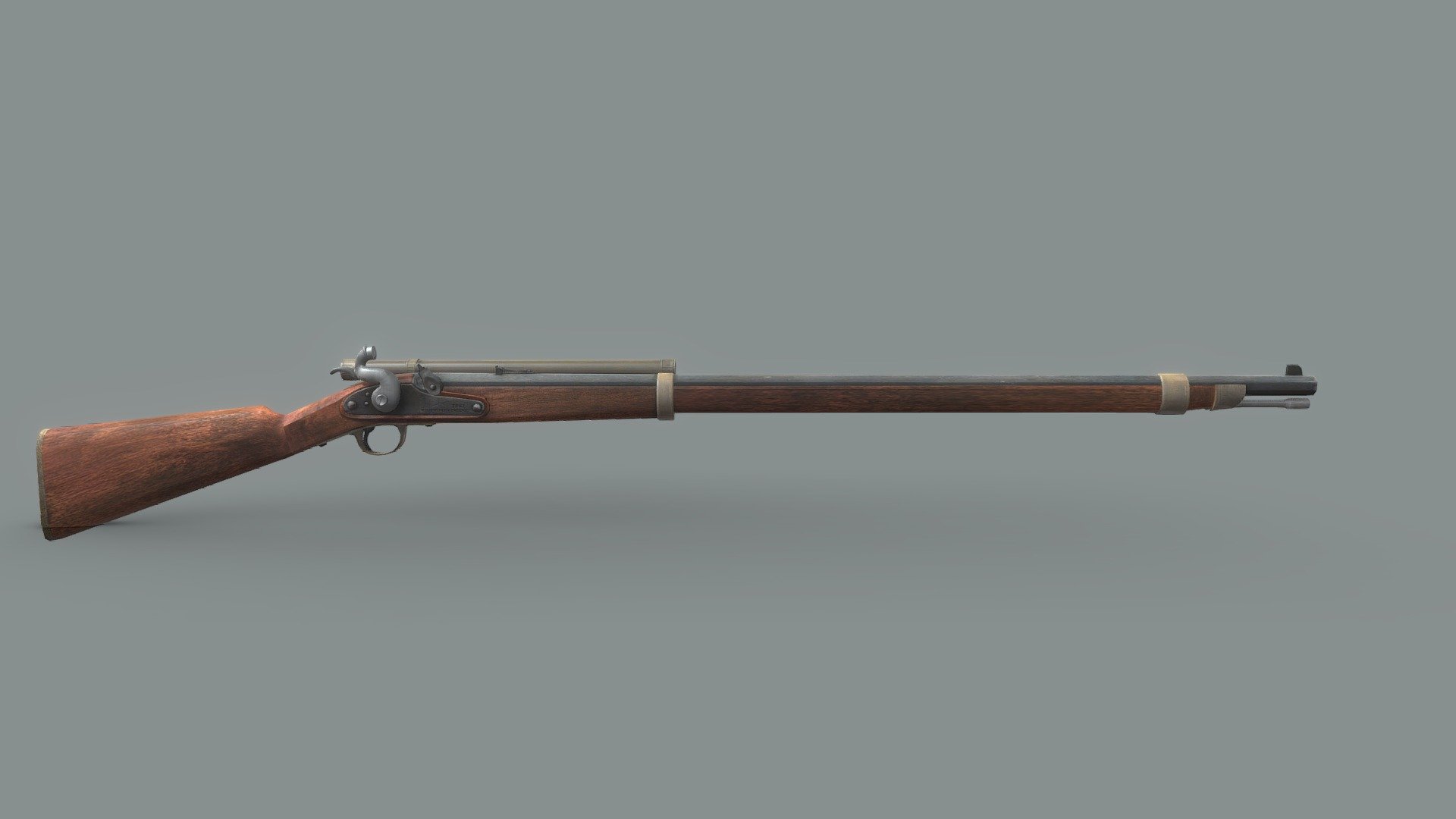
2. **The Whitworth Rifle: Pioneering Long-Range Accuracy**If the Baker rifle opened the door to military precision, the Whitworth rifle blew it wide open, arguably becoming “the first long-range sniper rifle in the world.” Designed by the brilliant British engineer Sir Joseph Whitworth, this muzzleloader pushed the boundaries of accuracy in the mid-19th century, addressing the shortcomings of standard issue weapons like the Pattern 1853 Enfield.
If the Baker rifle opened the door to military precision, the Whitworth rifle blew it wide open, arguably becoming “the first long-range sniper rifle in the world.” Designed by the brilliant British engineer Sir Joseph Whitworth, this muzzleloader pushed the boundaries of accuracy in the mid-19th century, addressing the shortcomings of standard issue weapons like the Pattern 1853 Enfield.
The Whitworth’s engineering marvel lay in its unique hexagonal, or “polygonal rifling.” This innovative barrel design meant that the projectile, also hexagonal, did not have to bite into grooves as was done with conventional rifling. Instead, it precisely fit the bore, creating a perfect seal and optimal spin. This drastically reduced barrel wear and improved ballistic performance, making it a true marvel of industrial design for its time.
Trials in 1857 unequivocally demonstrated its superiority, where it “outperformed the Enfield at a rate of about three to one.” The Whitworth rifle was capable of hitting targets at an astonishing “2,000 yards,” far exceeding the Enfield’s 1,400-yard capability. While not adopted by the British Army, its impact was felt elsewhere, famously being sold to “the French army, and also to the Confederacy during the American Civil War,” where its extreme accuracy led to legendary incidents, such as the fatal shot on Union General John Sedgwick at approximately 1,000 yards.
Military equipment: Sniper rifle
Categories: All articles lacking in-text citations, All articles with unsourced statements, All articles with vague or ambiguous time, Articles lacking in-text citations from April 2023, Articles with short description
Summary: A sniper rifle is a high-precision, long-range rifle. Requirements include high accuracy, reliability, mobility, concealment, and optics, for anti-personnel, anti-materiel and surveillance uses by military snipers. The modern sniper rifle is a portable shoulder-fired rifle with either a bolt action or semi-automatic action, fitted with a telescopic sight for extreme accuracy and chambered for a high-ballistic performance centerfire cartridge.
Get more information about: Sniper rifle

3. **Mosin–Nagant M1891/30: The Stalwart of the Eastern Front**
Few rifles are as synonymous with the gritty realities of 20th-century warfare and legendary marksmen as the Mosin–Nagant M1891/30. This robust bolt-action rifle, originally designed in the late 19th century, became the workhorse for Soviet forces and Finnish snipers during both World Wars, earning a reputation for its reliability and devastating effectiveness in the hands of trained snipers.
The Mosin-Nagant’s presence in the historical record is underscored by its association with some of the most successful snipers in history. “Vasily Zaytsev, left, and other Soviet snipers equipped with Mosin–Nagant M1891/30 during the Battle of Stalingrad in December 1942” showcased its prowess in urban combat. Even more remarkably, “Simo Häyhä is credited with 505 confirmed kills,” with “most with the Finnish version of the iron-sighted bolt-action Mosin–Nagant,” highlighting its incredible accuracy even without advanced optics.
During the brutal Battle of Stalingrad, Soviet snipers, often armed with the Mosin-Nagant, exploited the rubble-strewn cityscape to great effect, inflicting significant casualties and severely demoralizing German attackers. The rifle’s robust design, capable of enduring harsh winter conditions and prolonged field use, made it an ideal choice for the vast, unforgiving Eastern Front. Its simple, yet effective, mechanism allowed it to function reliably when more complex systems might have failed.

4. **Mauser Gewehr 98: German Precision in the Trenches**
The Imperial German Army entered World War I with a distinct advantage in sniper capability, largely due to their issuance of scoped Mauser Gewehr 98 rifles. This bolt-action design, already a staple infantry rifle, was adapted for precision work, making German snipers renowned for their deadliness and efficiency from the conflict’s outset.
The effectiveness of the Gewehr 98 as a sniper platform was a direct result of both its inherent mechanical accuracy and the superior quality of German optical manufacturing. “At first the French and British believed such hits to be coincidental hits, until the German scoped rifles were discovered,” a testament to the rifle’s unexpected precision. The “high-quality lenses that German industry could manufacture” for its telescopic sights further enhanced its long-range capabilities, allowing snipers to exploit vulnerabilities from concealed positions in the static trench warfare environment.
Even as the Second World War approached, the enduring quality of the Mauser design meant that “German Scharfschützen were prepared before the war, equipped with Karabiner 98 and later Gewehr 43 rifles, but there were often not enough of these weapons available, and as such some were armed with… scoped Gewehr 98 from WW1.” This continued reliance underscores the rifle’s solid engineering and fundamental suitability for precision shooting, cementing its legacy as a pivotal sniper system.
Military equipment: M1903 Springfield
Name: U.S. Rifle, Caliber .30, M1903
Origin: United States
Type: Bolt-action rifle
IsRanged: true
IsBladed: when needed
Service: 1903–1936 (as the standard U.S. service rifle),1936–1970s (as a U.S. Army sniper rifle)
UsedBy: #Users
Wars: item_style=text-indent: -1.5em; margin-left: 1.5em,Philippine–American War,Banana Wars,Mexican Revolution,World War I,Siberian Intervention,Irish War of Independence,Irish Civil War,Coto War,World War II,Egyptian revolution of 1952,Greek Civil War,First Indochina War,Chinese Civil War,Indonesian National Revolution,Korean War,Cuban Revolution,Hukbalahap Rebellion,Algerian War,Vietnam War,Laotian Civil War,Bay of Pigs Invasion,Cambodian Civil War
DesignDate: [object Object]
Manufacturer: Springfield Armory,Rock Island Arsenal,Remington Arms Company,Smith Corona
UnitCost: Inflation
ProductionDate: [object Object]
Number: 3,004,079
Variants: #Variants
Weight: 8.7 lbs
Abbr: on
Length: 43.2 in
PartLength: 24 in
Cartridge: .30-03 Springfield,.30-06 Springfield
Action: Bolt action
Rate: User dependent; usually 15 to 30 rounds per minute
Velocity: 2800 ft
Range: cvt
MaxRange: cvt
Feed: Magazine (firearms)
Sights: Flip-up rear sight graduated to {{cvt,2,700,yds,m
BladeType: Bayonet
Categories: .30-06 Springfield rifles, 7.62 mm rifles, All Wikipedia articles written in American English, All articles with failed verification, All articles with unsourced statements
Summary: The M1903 Springfield, officially the U.S. Rifle, Caliber .30, M1903, is an American five-round, non-removable, staggered-row box magazine-fed, bolt-action, repeating service rifle, used primarily during the first half of the 20th century.
The M1903 was first used in combat during the Philippine-American War and was officially adopted by the United States as the standard infantry rifle on 19 June 1903. It saw service in World War I and was replaced by the faster-firing semi-automatic eight-round M1 Garand starting in 1936. However, the M1903 remained a standard-issue infantry rifle during World War II, since the U.S. entered the war without sufficient M1 rifles to arm all troops. It also was used as a sniper rifle during World War II, the Korean War and the Vietnam War. It remains popular as a civilian firearm, collector’s piece, a competitive shooting rifle and as a military drill rifle.
Get more information about: M1903 Springfield

5. **M1903 Springfield: America’s Trusted Marksman Rifle**
The M1903 Springfield bolt-action rifle served as the primary infantry arm for the United States during World War I and saw extensive use as a sniper rifle in various configurations, including in the Pacific War. Its reputation for accuracy and reliability made it a natural choice for American marksmen needing to engage targets with precision in diverse and challenging environments.
During World War I, alongside other Allied sniper rifles, the M1903 Springfield was critical for establishing an effective counter-sniper presence against the formidable German snipers. Its robust design and effective range allowed American forces to adapt to the demands of trench warfare, where selective targeting could break enemy morale and disrupt command structures. The rifle’s inherent precision was a key factor in its success.
The M1903 Springfield’s versatility was further proven in the unforgiving jungles of the Pacific War, where “U.S. Marines… used M1903 Springfield rifles” to counter the camouflaged and patient Japanese snipers. While combat in the jungle typically occurred at shorter ranges, the rifle’s accuracy was still paramount for quick and decisive engagements, demonstrating its adaptability from the mud of Europe to the dense foliage of the Pacific Islands.
Military equipment: National Rifle Association
Name: National Rifle Association of America
Logo: National Rifle Association official logo.svg
LogoSize: 180px
Caption: Fair Oaks, Fairfax County, Virginia
Type: 501(c)(4)
TaxId: 53-0116130
FoundedDate: Start date and age
FoundingLocation: New York City
Founder: William Conant Church,George Wood Wingate
Location: Fair Oaks, Fairfax County, Virginia
KeyPeople: List of presidents of the National Rifle Association,Doug Hamlin
AreaServed: United States
Services: Lobbying,Membership organization,Magazine publisher,Education/certification
Focus: Gun politics in the United States,Gun rights
Method: Lobbying,Publications,Outreach
Revenue: USD
RevenueYear: 2024
Expenses: USD
ExpensesYear: 2024
NumMembers: [object Object]
Subsid: NRA Civil Rights Defense Fund,NRA Foundation,NRA Special Contribution Fund,NRA Freedom Action Foundation,Institute for Legislative Action,Political Victory Fund
Website: https://home.nra.org/
Categories: 1871 establishments in New York (state), 501(c)(4) nonprofit organizations, All Wikipedia articles in need of updating, All Wikipedia articles written in American English, All articles containing potentially dated statements
Summary: The National Rifle Association of America (NRA) is a gun rights advocacy group based in the United States. Founded in 1871 to advance rifle marksmanship, the modern NRA has become a prominent gun rights lobbying organization while continuing to teach firearm safety and competency. The organization also publishes several magazines and sponsors competitive marksmanship events. The group claimed nearly 5 million members as of December 2018, though that figure has not been independently confirmed.
The NRA is among the most influential advocacy groups in U.S. politics. The NRA Institute for Legislative Action (NRA-ILA) is its lobbying division, which manages its political action committee (PAC), the Political Victory Fund (PVF). Over its history, the organization has influenced legislation, participated in or initiated lawsuits, and endorsed or opposed various candidates at local, state, and federal levels. Some notable lobbying efforts by the NRA-ILA are the Firearm Owners Protection Act, which lessened restrictions of the Gun Control Act of 1968, and the Dickey Amendment, which blocks the Centers for Disease Control and Prevention (CDC) from using federal funds to advocate for gun control.
Starting in the mid- to late 1970s, the NRA has been increasingly criticized by gun control and gun rights advocacy groups, political commentators, and politicians. This criticism began following changes in the NRA’s organizational policies, following what is now referred to as the Revolt at Cincinnati at the 1977 NRA annual convention. The changes, which deposed former NRA executive vice president Maxwell Rich and included new organizational bylaws, have been described as moving the organization away from its previous focuses of “hunting, conservation, and marksmanship” and toward a focus on the defense of the right to bear arms. The organization has been the focus of intense criticism in the aftermath of high-profile shootings, such as the Sandy Hook Elementary School shooting and the Parkland High School shooting, after both of which they suggested adding armed security guards to schools.
Get more information about: National Rifle Association
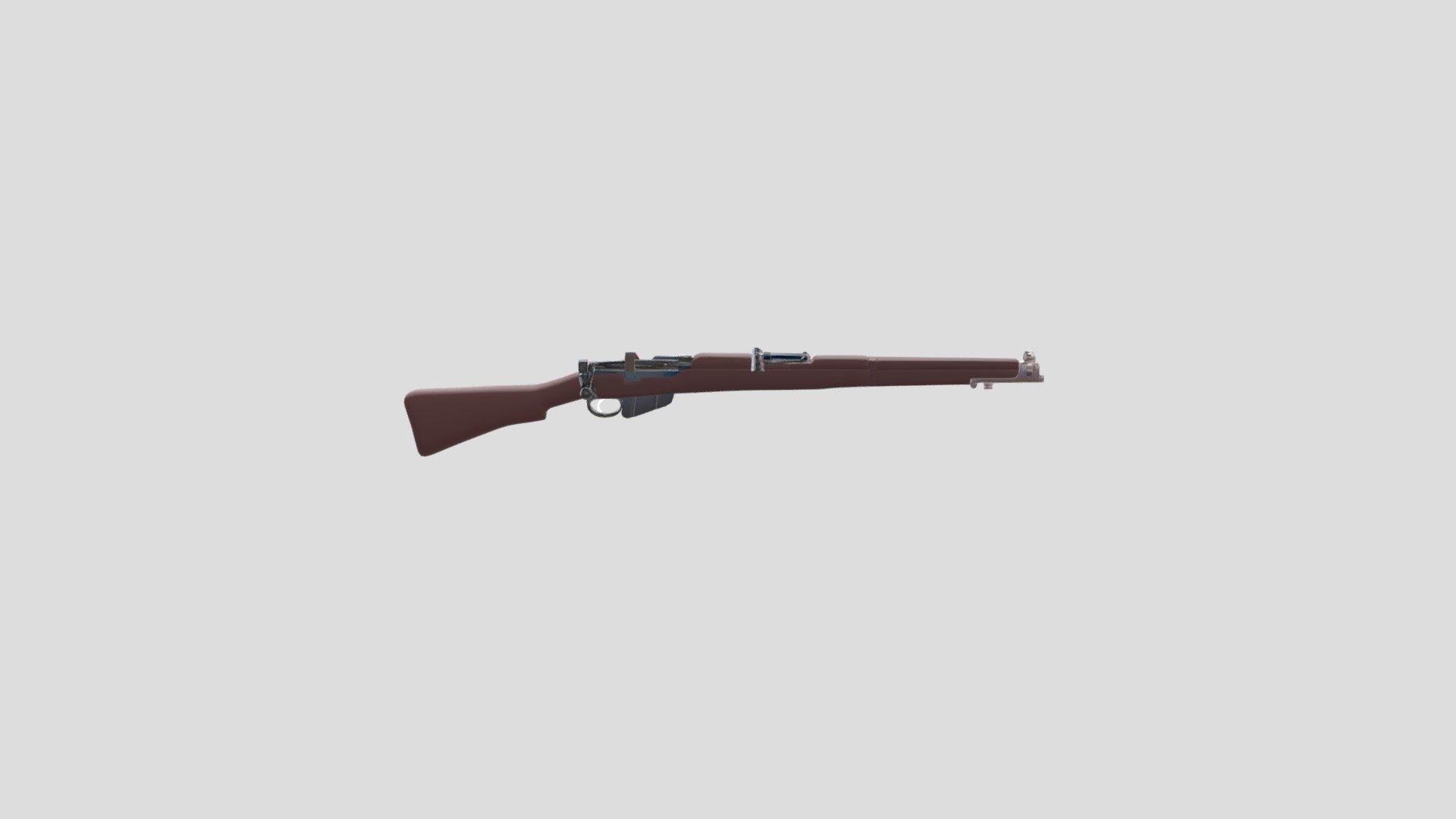
6. **Lee–Enfield No. 4 and SMLE Mk III: The British Empire’s Reliable Workhorse**
The British Lee–Enfield series of rifles, particularly the SMLE (Short Magazine Lee–Enfield) Mk III and its successor the No. 4, were the backbone of Commonwealth forces throughout the 20th century. While primarily standard infantry rifles, their smooth bolt action and considerable accuracy made them highly adaptable platforms for sniper variants, serving British and Allied marksmen with distinction in both World Wars.
In the crucible of World War I, the “British Pattern 1914 Enfield and Lee–Enfield SMLE Mk III” were utilized by newly trained British snipers, who quickly learned to operate in pairs, employing innovative tactics like “spotting scopes” and “dummy heads” to counter German precision. The inherent reliability and rapid-fire capability (for a bolt-action) of the Lee-Enfield, combined with specialized training, allowed it to be effectively converted into a formidable sniper system, often fitted with telescopic sights.
By World War II, the improved Lee–Enfield No. 4 continued this legacy, proving its worth across multiple theaters. British snipers, trained to “blend in with the environment, often by using special camouflage clothing for concealment,” relied on these rifles for their accuracy and robust performance. Despite facing limitations in the number of trained snipers, the Lee-Enfield platform remained a testament to reliable British engineering, capable of delivering precision under diverse and often brutal combat conditions.
Military equipment: List of weapons of the Portuguese Colonial War
Categories: Articles containing Portuguese-language text, Articles with short description, CS1 French-language sources (fr), CS1 Portuguese-language sources (pt), Lists of military equipment
Summary: The Portuguese Colonial War (Portuguese: Guerra Colonial), also referred to as the Portuguese Overseas War or Overseas War (Portuguese: Guerra do Ultramar) for short, was a military conflict staged during the Decolonisation of Africa that pitted the guerrilla forces of the African nationalist Liberation movements of the Guinea-Bissau, Angola and Mozambique overseas provinces, which were part of the Portuguese Empire, against the colonial armed and security forces loyal to the authoritarian Estado Novo regime of Portugal, between 1961 and 1975. Main combatants comprised:
The Portuguese Armed Forces (Portuguese: Forças Armadas), which were backed by the United States, United Kingdom, West Germany, France, Francoist Spain, Belgium, Rhodesia and South Africa, were the official military of Portugal. Subordinated to the Ministry of National Defence and placed under the command of the Secretariat-General of National Defence (Portuguese: Secretariado-Geral da Defesa Nacional – SGDN), of the Portuguese government at the capital Lisbon, the branches were organized as follows:
The Portuguese Army (Portuguese: Exército Português)
The Portuguese Air Force (Portuguese: Força Aérea Portuguesa), or FAP in the Portuguese acronym but internationally is often referred to by the acronym PRTAF.
The Portuguese Navy (Portuguese: Marinha Portuguesa), also known as Marinha de Guerra Portuguesa or as Armada Portuguesa.
The Portuguese Security Forces, subordinated to the Overseas Ministry (Portuguese: Ministério do Ultramar) in Lisbon:
The Public Security Police (Portuguese: Polícia de Segurança Pública – PSP), the uniformed Preventive police (actually, a Colonial police force) of the Portuguese overseas territories, which was modelled after the European Portuguese PSP, the national civil police force of Portugal.
The irregular Auxiliary Forces (Portuguese: Forças Auxiliares).
The African nationalist Liberation movements:
The African Party for the Independence of Guinea and Cape Verde (Portuguese: Partido Africano para a Independência da Guiné e Cabo Verde – PAIGC) party (1956–present), and its military wing the Revolutionary Armed Forces of the People (Portuguese: Forças Armadas Revolucionárias do Povo – FARP), which received support from the Soviet Union, East Germany, Poland, Czechoslovakia, the Socialist Republic of Romania, SFR Yugoslavia, the People’s Republic of Bulgaria, Sweden, North Korea, the People’s Republic of China, Cuba, Libya, Ghana, Senegal, and Guinea-Conacry.
The People’s Movement for the Liberation of Angola (Portuguese: Movimento Popular de Libertação de Angola – MPLA) party (1956–present), and its military wing the People’s Army for the Liberation of Angola (Portuguese: Exército Popular de Libertação de Angola – EPLA), which received support from the Soviet Union, East Germany, Cuba, Morocco, Algeria, Republic of the Congo, Ghana, Guinea-Conacry, Tanzania, and Zambia.
The National Front for the Liberation of Angola (Portuguese: Frente Nacional de Libertação de Angola – FNLA) party (1961–present), and its military wing the National Army for the Liberation of Angola (Portuguese: Exército de Libertação Nacional de Angola – ELNA), which received support from the United States, the People’s Republic of China, West Germany, Israel, France, the Socialist Republic of Romania, Morocco, Algeria, Tunisia, Ghana, Zaire, and Liberia.
The National Union for the Total Independence of Angola (Portuguese: União Nacional para a Independência Total de Angola – UNITA) party (1966–present), and its military wing the Armed Forces of the Liberation of Angola (Portuguese: Forças Armadas de Libertação de Angola – FALA), which received support from the People’s Republic of Bulgaria, the People’s Republic of China, Egypt, and Zambia.
The Front for the Liberation of the Enclave of Cabinda (Portuguese: Frente para a Libertação do Enclave de Cabinda – FLEC) party (1963–present), which received support from the United States, France, Zaire, and South Africa.
The Liberation Front of Mozambique (Portuguese: Frente de Libertação de Moçambique – FRELIMO) party (1962–present), and its military wing the Popular Forces for the Liberation of Mozambique (Portuguese: Forças Populares de Libertação de Moçambique – FPLM), which received support from the Soviet Union, East Germany, the People’s Republic of Bulgaria, Czechoslovakia, Poland, SFR Yugoslavia, Sweden, Norway, Denmark, the Netherlands, Cuba, the People’s Republic of China, Algeria, Libya, Egypt, Republic of the Congo, Tanzania, and Zambia.
An eclectic variety of weapons was used by all sides in the Portuguese Colonial War. The Portuguese Military and Security Forces serving in the African territories were equipped with Western-made weapon systems from both World War I and World War II, mainly Portuguese, Austro-Hungarian, Danish, German, Italian, French, Canadian and British in origin, but also included more modern Portuguese, Spanish, French, British, Belgian, Dutch, West German, American and South African military hardware. During the early phase of the war, the African Liberation Movements likewise were largely equipped with WWII-vintage Western arms and munitions, though as the war went on, Soviet, Eastern Bloc and Chinese weaponry began to play a major role, particularly after 1970.
Get more information about: List of weapons of the Portuguese Colonial War
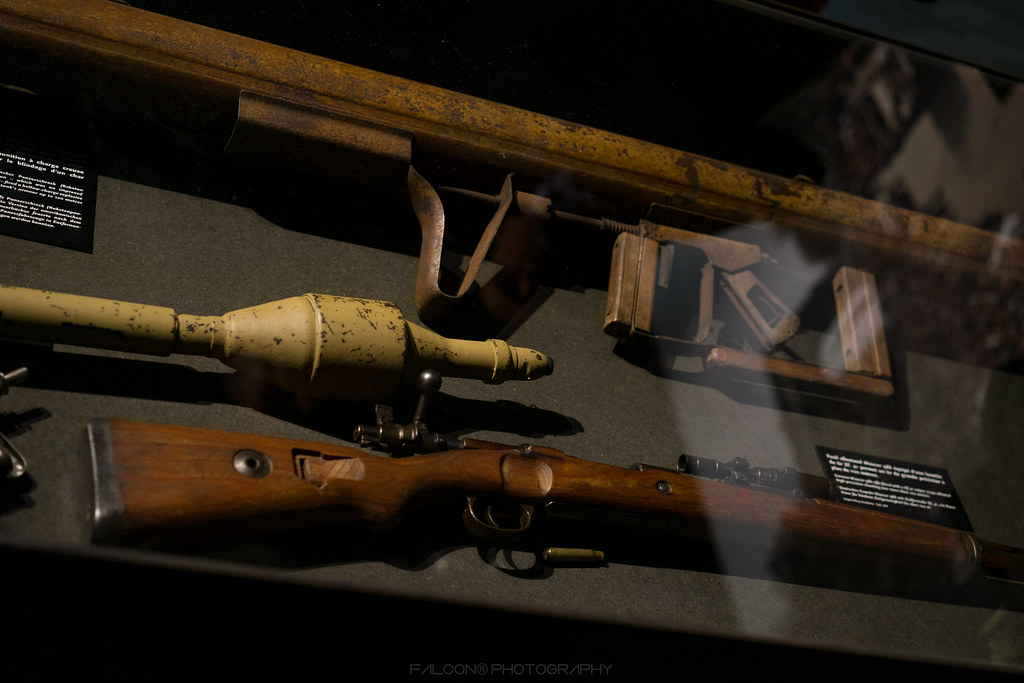
7. **Karabiner 98k: The German Sniper’s Standard Bearer of WWII**
Building upon the illustrious lineage of Mauser designs, the Karabiner 98 kurz, or Kar98k, emerged as the primary bolt-action rifle for the German Wehrmacht in World War II. Adapted with high-quality optics, it became the standard sniper rifle for German Scharfschützen, cementing its place as an icon of precision and effectiveness on the battlefield.
The Kar98k’s strength as a sniper system stemmed from its robust construction, reliable action, and excellent inherent accuracy. German snipers, renowned for their advanced training and tactical prowess, wielded these rifles to devastating effect. The context notes that “German Scharfschützen were prepared before the war, equipped with Karabiner 98 and later Gewehr 43 rifles,” indicating its immediate integration into their specialized units.
A key aspect of the Kar98k’s performance was its pairing with advanced accessories and ammunition. German snipers often used “the Zeiss Zielvier 4x (ZF39) telescopic sight” and were “the only snipers in the world issued with purpose-manufactured sniping ammunition, known as the ‘effect-firing’ sS round.” This match-grade ammunition, featuring a “heavy 12.8 gram (198 gr) full-metal-jacketed boat-tail projectile,” further enhanced the rifle’s already high precision, allowing German marksmen to achieve remarkable accuracy and extend their effective range in critical engagements. The Kar98k, therefore, represents a pinnacle of World War II sniper engineering and doctrine.
Having journeyed through the foundational designs that carved out the very concept of precision marksmanship on the battlefield, we now turn our attention to the cutting edge. The demands of modern warfare have pushed engineers to new heights, resulting in weapon systems that offer unprecedented accuracy, extended range, and specialized capabilities, particularly in the realm of anti-materiel engagement. These are the rifles that define contemporary long-range precision, empowering today’s snipers to engage targets with pinpoint accuracy across vast distances, often exceeding the wildest dreams of their historical counterparts.
The evolution from early rifled muskets to today’s high-tech sniper systems is nothing short of incredible. These modern marvels are not just firearms; they are complex instruments, integrating advanced ballistics, superior optics, and robust engineering to maintain their critical ‘zero calibration’ even after thousands of miles of arduous field transport. Let’s delve into the advanced systems that represent the pinnacle of modern sniper technology, systems that continue to push the boundaries of what is possible in precision long-range combat and strategic targeting.
Military equipment: Squad
Categories: All articles with dead external links, All articles with incomplete citations, Articles containing Spanish-language text, Articles with dead external links from October 2013, Articles with incomplete citations from November 2012
Summary: In military terminology, a squad is among the smallest of military organizations and is led by a non-commissioned officer. NATO and U.S. doctrine define a squad as an organization “larger than a team, but smaller than a section”, while U.S. Army doctrine further defines a squad as a “small military unit typically containing two or more fire teams. It typically contains
a dozen Soldiers or less.” In the Australian, British and Canadian Armed Forces the equivalent of a squad is a section.
The Canadian Forces Manual of Drill and Ceremonial defines a squad as “a small military formation of less than platoon size which is adopted to teach drill movements. (escouade)”.
A squad can also be an ad hoc group of soldiers assigned to a task, for example, a firing squad.
Get more information about: Squad

8. **Barrett M82: The Anti-Materiel Icon**
When discussing modern sniper systems, it’s impossible to overlook the formidable Barrett M82. This semi-automatic, recoil-operated rifle, chambered in the powerful .50 BMG (12.7×99mm NATO) cartridge, redefined the role of the sniper rifle by ushering in the era of anti-materiel engagement. It’s not just for taking down enemy personnel; its sheer power allows snipers to destroy military equipment from considerable distances.
The M82’s robust design and heavy caliber make it ideal for specific tactical missions where traditional sniper rifles fall short. It is explicitly mentioned in military doctrine discussions as a prime example of an “anti-materiel rifle” necessary for the “destruction of military equipment.” Its utility extends to targets such as light armored vehicles, radar dishes, parked aircraft, and even explosive ordnance disposal. The iconic image of a “U.S. Army sniper using a Barrett M82” underscores its widespread adoption and crucial role in modern military operations.
Its semi-automatic action allows for rapid follow-up shots, a significant advantage in certain combat scenarios compared to traditional bolt-action sniper rifles. While its primary role is anti-materiel, the M82 has also proven effective in neutralizing personnel at extreme ranges. Its presence on the battlefield signifies a strategic capability to influence engagements beyond direct infantry combat, embodying the shift towards versatile, high-impact sniper systems.
Military equipment: Firearm
Categories: All articles containing potentially dated statements, All articles lacking reliable references, All articles needing additional references, All articles with dead external links, All articles with unidentified words
Summary: A firearm is any type of gun that uses an explosive charge and is designed to be readily carried and operated by an individual. The term is legally defined further in different countries (see legal definitions).
The first firearms originated in 10th-century China, when bamboo tubes containing gunpowder and pellet projectiles were mounted on spears to make the portable fire lance, operable by a single person, which was later used effectively as a shock weapon in the siege of De’an in 1132. In the 13th century, fire lance barrels were replaced with metal tubes and transformed into the metal-barreled hand cannon. The technology gradually spread throughout Eurasia during the 14th century. Older firearms typically used black powder as a propellant, but modern firearms use smokeless powder or other explosive propellants. Most modern firearms (with the notable exception of smoothbore shotguns) have rifled barrels to impart spin to the projectile for improved flight stability.
Modern firearms can be described by their caliber (i.e. bore diameter). For pistols and rifles this is given in millimeters or inches (e.g. 7.62mm or .308 in.); in the case of shotguns, gauge or bore (e.g. 12 ga. or .410 bore.). They are also described by the type of action employed (e.g. muzzleloader, breechloader, lever, bolt, pump, revolver, semi-automatic, fully automatic, etc.), together with the usual means of deportment (i.e. hand-held or mechanical mounting). Further classification may make reference to the type of barrel used (i.e. rifled) and to the barrel length (e.g. 24 inches), to the firing mechanism (e.g. matchlock, wheellock, flintlock, or percussion lock), to the design’s primary intended use (e.g. hunting rifle), or to the commonly accepted name for a particular variation (e.g. Gatling gun).
Shooters aim firearms at their targets with hand-eye coordination, using either iron sights or optical sights. The accurate range of pistols generally does not exceed 100 metres (110 yd; 330 ft), while most rifles are accurate to 500 metres (550 yd; 1,600 ft) using iron sights, or to longer ranges whilst using optical sights. Purpose-built sniper rifles and anti-materiel rifles are accurate to ranges of more than 2,000 metres (2,200 yd). (Firearm rounds may be dangerous or lethal well beyond their accurate range; the minimum distance for safety is much greater than the specified range for accuracy.)
Get more information about: Firearm
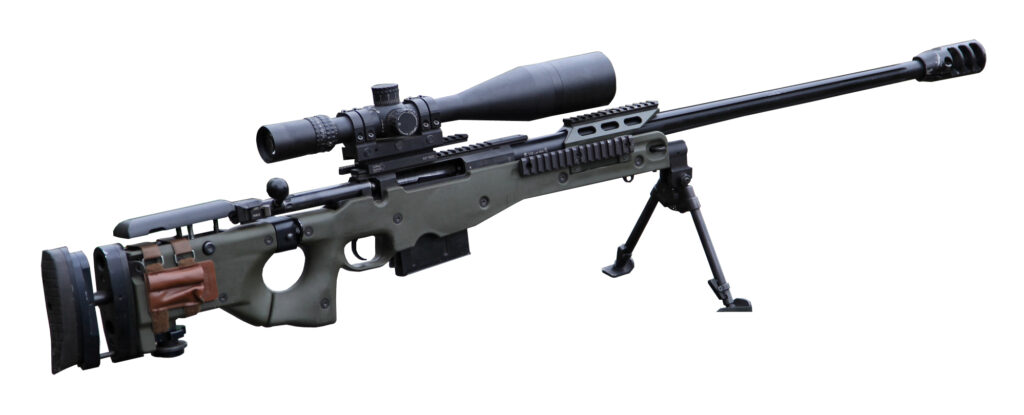
9. **Accuracy International AWM: Precision for the Modern Warrior**
The Accuracy International Arctic Warfare Magnum (AWM) stands as a testament to British engineering in the realm of precision sniper rifles. Widely adopted by military and law enforcement agencies globally, this bolt-action rifle is renowned for its exceptional accuracy and reliability in demanding conditions. It represents the pinnacle of high-precision rifles, often paired with high-magnification optics, as seen with French and British snipers.
The AWM’s design focuses on modularity and user-friendliness, allowing for easy maintenance and adaptation to various operational environments. Its robust construction ensures consistent performance, crucial for maintaining zero calibration even after extensive field use and transport. This reliability makes it a trusted companion for snipers operating in diverse climates, from arid deserts to freezing arctic terrains.
Chambered in cartridges like the potent .338 Lapua Magnum, the AWM offers an extended effective range and superior terminal ballistics compared to smaller calibers. This allows snipers to engage targets with devastating effect at distances well beyond 1,000 meters, solidifying its place as a preferred choice for special forces and elite military units requiring utmost precision for long-range engagements.
Military equipment: Sniper
Name: Sniper
Type: Law enforcement
ActivitySector: Sniper rifle
Caption: FR F2,Accuracy International AWM
Categories: All articles containing potentially dated statements, All articles needing additional references, All articles with dead external links, All articles with unsourced statements, Articles containing French-language text
Summary: A sniper is a military or paramilitary marksman who engages targets from positions of concealment or at distances exceeding the target’s detection capabilities. Snipers generally have specialized training and are equipped with telescopic sights. Modern snipers use high-precision rifles and high-magnification optics. They often also serve as scouts/observers feeding tactical information back to their units or command headquarters.
In addition to long-range and high-grade marksmanship, military snipers are trained in a variety of special operation techniques: detection, stalking, target range estimation methods, camouflage, tracking, bushcraft, field craft, infiltration, special reconnaissance and observation, surveillance and target acquisition. Snipers need to have complete control of their bodies and senses in order to be effective. They also need to have the skill set to use data from their scope and monitors to adjust their aim to hit targets that are extremely far away. In training, snipers are given charts that they’re drilled on to ensure they can make last-minute calculations when they are in the field.
Get more information about: Sniper
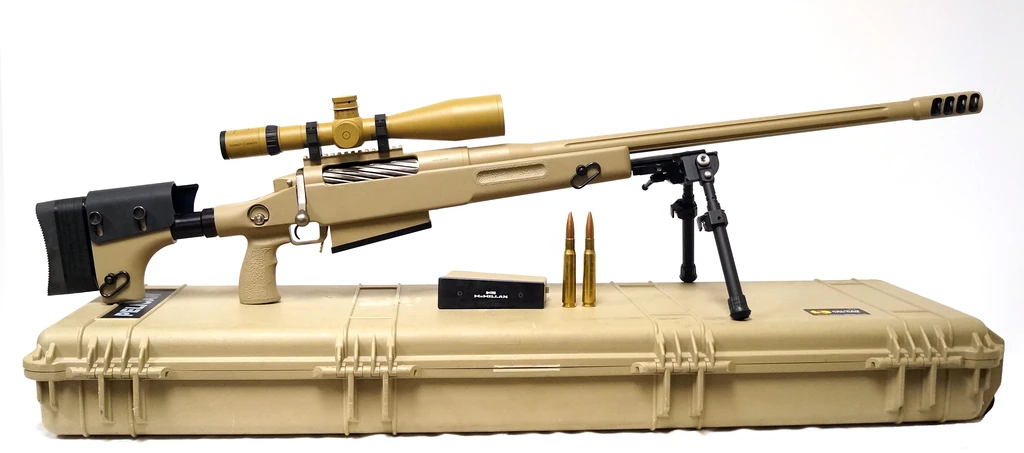
10. **McMillan Tac-50: The Record Breaker**
The McMillan Tac-50 is more than just another .50 BMG anti-materiel rifle; it’s a legendary system responsible for setting and holding the world record for the longest confirmed sniper kill for an extended period. This bolt-action, manually operated rifle, manufactured by McMillan Firearms, is a staple for special forces, including those of Canada, where it gained significant renown.
Its association with record-breaking precision is profound. A “member of the Canadian JTF2 special forces” utilized this rifle in June 2017 to achieve a hit at an astonishing “3,540 m (3,871 yd),” a feat that stood as the longest confirmed sniper kill in combat until a more recent incident in 2023. This achievement underscores the rifle’s extraordinary accuracy and the exceptional skill of the marksmen wielding it.
The Tac-50’s meticulous construction, combined with its large caliber, provides the power and stability needed for extreme long-range shooting. While not explicitly detailed, the ability to make such a shot speaks volumes about the rifle’s inherent precision and its capacity to consistently hold zero calibration under immense stress. It’s a firearm designed for environments where precision is not just desired, but absolutely critical for mission success.
Military equipment: 2025 deaths in the United States
Categories: 2025 in the United States, All articles lacking reliable references, Articles lacking reliable references from March 2025, Articles lacking reliable references from October 2025, Articles with Chinese-language sources (zh)
Summary: The following notable deaths in the United States occurred in 2025. Names are reported under the date of death, in alphabetical order.
A typical entry reports information in the following sequence:
Name, age, country of citizenship at birth and subsequent nationality (if applicable), what subject was noted for, year of birth (if known), and reference.
Get more information about: 2025 deaths in the United States

11. **L115A3 Long Range Rifle: The British Long-Range Champion**
The L115A3 Long Range Rifle, a highly specialized variant of the Accuracy International Arctic Warfare series, is perhaps best known for its role in one of the most remarkable long-range engagements in military history. This British military designation highlights a rifle engineered for extreme precision, specifically tailored for extended-range target interdiction.
Its fame was cemented by Craig Harrison, a Corporal of Horse in the British Army, who in November 2009 “struck two Taliban machine gunners consecutively… at a range of 2,475 m (2,707 yd) or 1.54 miles using a L115A3 Long Range Rifle.” This incredible feat, detailed with fascinating ballistic calculations, showcased the rifle’s immense capabilities. The context notes that such shots would have traveled for “nearly 6.0 seconds,” losing “93% of their kinetic energy,” and dropping a staggering “121.39 m (398 ft 3 in)” from the original bore line.
Harrison’s legendary shot required precise environmental compensation, with the calculation assuming “a flat-fire scenario” and using “British military custom high-pressure .338 Lapua Magnum cartridges, loaded with 16.2 g (250 gr) Lapua LockBase B408 bullets.” Despite the challenges, including a potential 9.2-meter diversion from a mere “2.7 m/s (6.0 mph) cross-breeze,” Harrison reported “perfect” environmental conditions, making the improbable possible. This rifle, therefore, symbolizes the perfect synergy between advanced weapon design and unparalleled human skill.
Military equipment: British military rifles
Categories: All Wikipedia articles written in British English, All articles needing additional references, All articles with unsourced statements, Articles needing additional references from April 2017, Articles with short description
Summary: The origins of the modern British military rifle are within its predecessor the Brown Bess musket. While a musket was largely inaccurate over 100 yards (91 m), due to a lack of rifling and a generous tolerance to allow for muzzle-loading, it was cheap to produce and could be loaded quickly. The use of volley or mass firing by troops meant that the rate of fire took precedence over accuracy.
Beginning in the late 1830s, the superior characteristics of the new rifles caused the British military to phase out the venerable .75 calibre Brown Bess musket in favour of muzzle-loading rifles in smaller calibres. Early rifles were non-standard and frequently used adaptations from components of the Brown Bess, including locks and stocks adapted to new rifled barrels. It was not until the late 19th century that the rifle fully supplanted the musket as the weapon of the infantryman.
Get more information about: British military rifles

12. **PGM Hécate II: French Anti-Materiel Prowess**
From France emerges the PGM Hécate II, another formidable large-caliber sniper rifle that firmly plants itself in the category of anti-materiel weapon systems. Seen alongside the Accuracy International AWM in modern military contexts, the Hécate II represents a significant contribution to contemporary long-range engagement capabilities, particularly for the French military and other special forces.
Like its .50 BMG counterparts, the Hécate II is designed to deliver exceptional power and accuracy for engaging a range of targets beyond mere personnel. Its robust construction ensures stability and repeatable precision, vital characteristics for a rifle that might be transported across vast distances and deployed in diverse combat zones while maintaining its critical ‘zero.’
While specific details about its operational use in the provided context are limited to its visual presence with French and British snipers in 2012, its very inclusion underscores its status as a high-precision, large-caliber instrument of strategic targeting. It embodies the modern sniper’s expanded role, enabling the neutralization of threats that require a heavier punch than standard sniper rounds can provide.
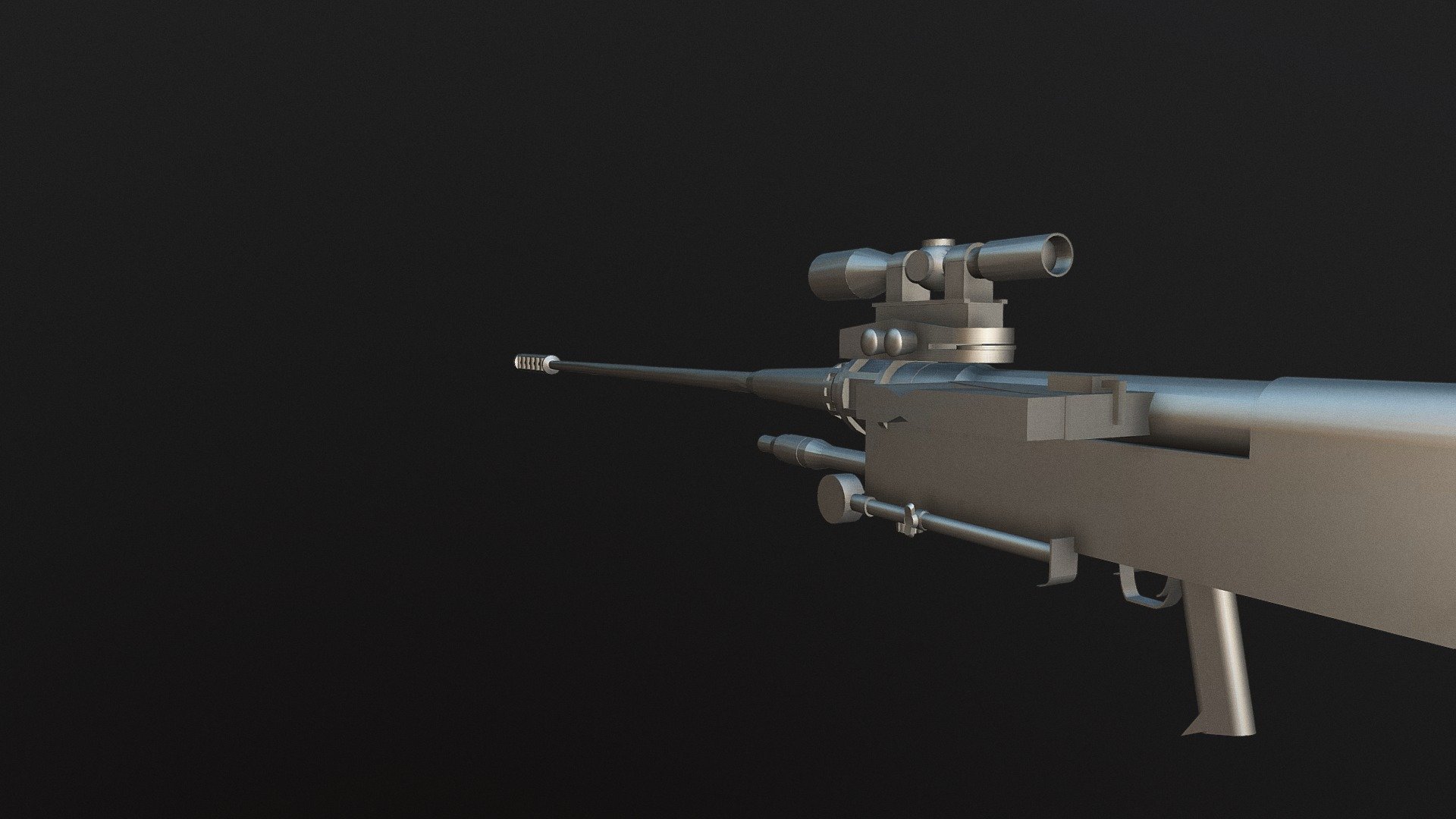
13. **Denel NTW-20: The Multi-Caliber Heavy Hitter**
The Denel NTW-20, developed in South Africa, is an anti-materiel rifle that truly pushes the boundaries of large-caliber precision. What sets it apart is its unique ability to be easily converted between different calibers, specifically 20x82mm and 14.5x114mm, by simply changing the barrel, bolt, and magazine. This makes it an incredibly versatile system for strategic targeting.
Its immense size and devastating firepower are designed for engaging high-value, hardened targets like radar installations, command and control vehicles, and even low-flying aircraft. The rifle’s ability to switch between calibers offers tactical flexibility, allowing snipers to adapt their payload to the specific requirements of a mission, whether it demands the sheer explosive power of the 20mm round or the longer-range, flatter trajectory of the 14.5mm.
As a dedicated anti-materiel rifle, the NTW-20 exemplifies the advanced capabilities of modern sniper weapon systems in their expanded role beyond traditional marksmanship. It’s a specialized tool for when overwhelming destructive force needs to be delivered with the precision of a sniper, underscoring the innovative spirit in contemporary firearms engineering for maintaining that crucial zero, even with such powerful calibers.
Military equipment: List of infantry equipment of the Indian Army
Categories: All articles with unsourced statements, Articles with short description, Articles with unsourced statements from August 2024, CS1: unfit URL, CS1 errors: generic name
Summary: The below is a list of current infantry equipment of the Indian Army and its future equipment procurements.
Get more information about: List of infantry equipment of the Indian Army
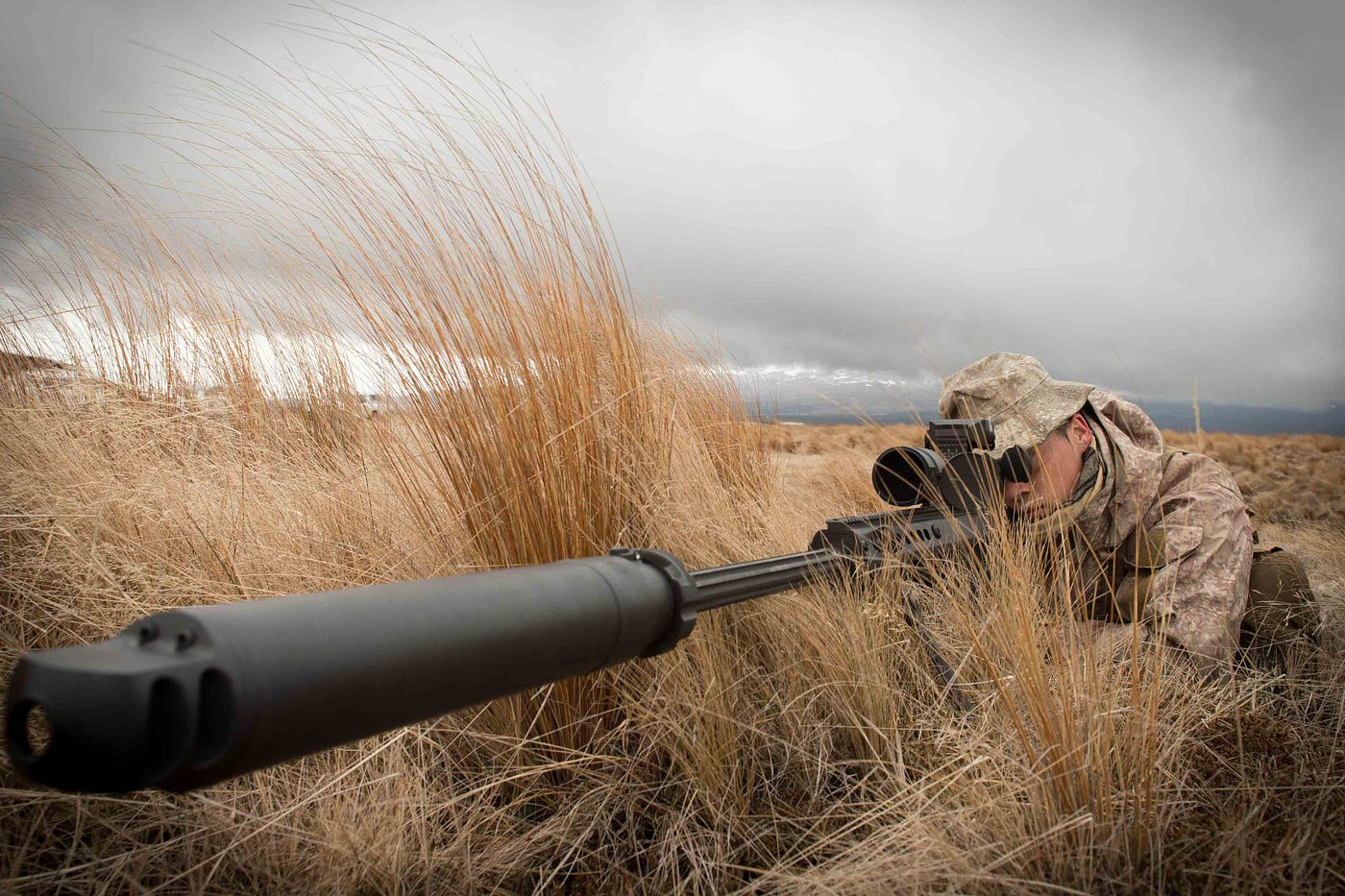
14. **Barrett MRAD: Modern Adaptability and Precision**
Bringing our survey of modern sniper systems to a close, the Barrett MRAD (Multi-Role Adaptive Design) represents the next generation in adaptable, high-precision rifles. Seen in the hands of elite units like the “YAMAM (Israel’s counter-terrorism unit) sniper shooting with suppressed Barrett MRAD sniper rifles,” this platform highlights the increasing demand for versatility and user-configurability in tactical firearms.
The MRAD is engineered with a focus on modularity, allowing for rapid caliber changes and extensive customization to meet diverse mission requirements. This adaptability, combined with Barrett’s reputation for rugged reliability, ensures that the rifle can maintain its precise zero calibration even after extensive transport and repeated field use, a critical factor for any modern sniper system.
Its capability to be fitted with suppressors, as noted in the context, further enhances its tactical utility, reducing muzzle flash and sound signature, which are vital for concealed operations. The MRAD embodies the forward-thinking design philosophy that prioritizes both extreme accuracy and operational flexibility, making it a powerful tool for law enforcement and military snipers who face a constantly evolving array of threats and environments.
Military equipment: AGM-154 Joint Standoff Weapon
Contractor: Raytheon Co.
Service: Joint
Date Deployed: January 1999
Length: 160 inches
Diameter: 13 inches
Wingspan: 106 inches
Weight: 1,065
Range: Low-altitude, 12 nautical miles; high-altitude, 63 nautical miles.
Guidance System: GPS/INS (Global Position/Inertial), Terminal IR Seeker (AGM-154C unique)
Platforms: Navy: F/A-18 C/D, F/A-18 E/F, AV-8B, F-35. Air Force: F-16 Block 40/50, B-1, B-2, B-52, F-15, F-117, A-10, F-35A.
Warhead: AGM-154A/145 BLU-97 combined-effects bomblets; AGM-154A-1, 500-pound BLU-111 warhead; AGM-154B, six P3I BLU-108 sensor-fuzed-weapon submunitions; AGM-154C, Broach multi-stage warhead.
Categories: Air Force Equipment, Air Force Ordnance, Bombs, Marine Corps Equipment, Marine Corps Ordnance
Get more information about: AGM-154 Joint Standoff Weapon
From the pioneering Baker Rifle to these sophisticated anti-materiel titans and adaptable multi-caliber platforms, the journey of the sniper rifle is a thrilling narrative of relentless innovation. Each system, a masterpiece of engineering, has been designed not just to shoot, but to do so with unwavering precision, holding its ‘zero’ against the relentless forces of physics and the brutal realities of the battlefield. These weapons, coupled with the extraordinary skill and unwavering resolve of the snipers who wield them, continue to redefine the boundaries of long-range engagement, ensuring that the art of the precise shot remains a pivotal force in strategic operations. The evolution is ongoing, and the quest for perfect precision, unyielding reliability, and adaptable power continues to inspire new heights in weapon design.


